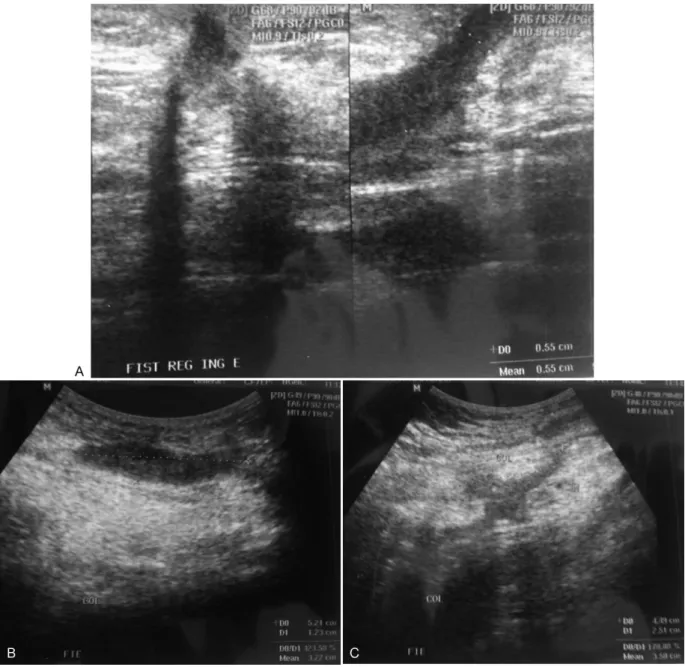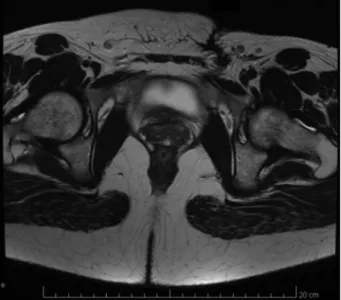Tubocutaneous Fistula due to Endometriosis
–
A
Differential Diagnosis in Cutaneous Fistulas with
Cyclic Secretion
Fístula tubocutânea secundária à endometriose
–
diagnóstico
diferenciado em fístulas cutâneas com secreção cíclica
Edinari Nunes de Sousa Lopes
1Lia Cruz Vaz da Costa Damásio
1Laio Santana Passos
11Department of Gynecology, Universidade Federal do Piauí - UFPI,
Teresina, Brazil
Rev Bras Ginecol Obstet 2017;39:31–34.
Address for correspondence Edinari Nunes de Sousa Lopes, MD, Departmento de Ginecologia, Universidade Federal do Piauí - UFPI, Av. Universitária–Ininga, Teresina, PI, Brazil 64049-550
(e-mail: edinarinunes@hotmail.com).
Introduction
Endometriosis is a benign disease defined by the presence of endometrial glands and stroma outside the uterus.1The average age at diagnosis is between 25 and 35 years.2,3Endometriosis outside the pelvis is rare, and most cases occur in surgical scars after procedures involving the female genital tract.4In this report, we present a rare case of tubocutaneousfistula due to endometriosis that developed after a cesarean section. The
fistula stretched from the left uterine tube to the left inguinal region along the anatomical path of the round ligament.
Case Report
A 34-year-old woman sought the surgery service of the University Hospital of Teresina in August 2015 due to a history of discharge from a cutaneous opening in the left iliac fossa that had varied in color from citric yellow to red
Keywords
►
gynecology
►
endometriosis
►
fi
stula
Abstract
The development of a tubocutaneous
fi
stula due to endometriosis in a post-cesarean
section surgical scar is a rare complication that generates signi
fi
cant morbidity in the
affected women. Surgery is the treatment of choice in these cases. Hormonal therapies
may lead to an improvement in symptoms, but do not eradicate such lesions. In this
report, we present a 34-year-old patient with a cutaneous
fi
stula in the left iliac fossa
with cyclic secretion. Anamnesis, a physical examination, and supplementary tests led
us to suggest endometriosis as the main diagnosis, which was con
fi
rmed after surgical
intervention.
Palavras-chave
►
ginecologia
►
endometriose
►
fístula
Resumo
O desenvolvimento de fístula tubocutânea secundária à endometriose em cicatriz
cirúrgica após cesariana é uma complicação rara, que gera importante morbidade às
mulheres acometidas. A cirurgia é o tratamento de escolha nesses casos. Terapias
hormonais podem conduzir a uma melhora dos sintomas, mas, de forma alguma,
levam à erradicação de tais lesões. No presente relato, temos uma paciente de 34 anos
de idade que apresentava uma fístula cutânea em fossa ilíaca esquerda com secreção
cíclica. Anamnese, exame físico e exames complementares nos levaram a aventar como
principal hipótese diagnóstica a endometriose, que foi con
fi
rmada após intervenção
cirúrgica.
received
June 11, 2016
accepted
November 17, 2016
DOIhttp://dx.doi.org/ 10.1055/s-0036-1597754.
ISSN 0100-7203.
Copyright © 2017 by Thieme-Revinter Publicações Ltda, Rio de Janeiro, Brazil THIEME
and had exhibited cyclical behavior over the course of six years. She presented with the following obstetrical history: one miscarriage late in 1999; two vaginal deliveries at term, one in 2002 and another in 2003; and one cesarean section in 2008, which interrupted a pregnancy of between 35 and 36 weeks, due to history of anemia and severe thrombocyto-penia associated with maternal-fetal Rh incompatibility.
Regarding the medical history related to the cesarean birth, the patient reported that six months after the cesarean section, she resumed regular menstrual cycles, which were associated with pain and redness in the left iliac fossa, abdominal disten-sion, and fever. At the time,fluid collection in the left inguinal region was diagnosed, and drainage was performed with seros-anguineous secretion. The patient showed a partial improve-ment in the symptoms, and, a few months later, a serous discharge in the collection area began, which was cyclical,
and it appeared eight days before menstruation and lasted until the end of the menstrual period. Thereafter, she was subjected to two more surgical procedures, including adhesiolysis in the
fistula tract and drainage collection. The patient was in posses-sion of the histopathological results of the latter approach (performed in 2013), which showed a foreign body-type chronic granulomatous inflammation and nonspecific lymphadenitis.
Based on this clinical background, the patient was referred to the hospital’s gynecology team with a diagnosis of tubocuta-neousfistula due to endometriosis. A gynecological examina-tion revealed the presence of a pfannenstiel scar and a longitudinal scar on the left iliac fossa, and a speculum exami-nation showed no communication of the vaginal walls with the
fistula. The patient underwent additional tests. An abdominal ultrasound examination showed: a hypoechoic tract with a diameter of 0.5 cm, located in the left inguinal region
Fig. 1 Abdominal ultrasound showing a hypoechoic tract located in the left inguinal region (panel A); a hypoechoic area located in the subcutaneous tissue, suggestingfluid collection, and showing communication with the external environment through the aforementioned tract (panel B); and a second hypoechoic area, showing communication with the aforementioned lesion, located close to the abdominal and internal oblique rectal muscles, suggestive offluid collection (panel C).
Rev Bras Ginecol Obstet Vol. 39 No. 1/2017
Tubocutaneous Fistula due to Endometriosis Lopes et al.
(►Fig. 1A); a hypoechoic area, with partially defined limits,
located in the subcutaneous tissue, measuring 5.21.2 cm,
suggestingfluid collection, and showing communication with the external environment through the aforementioned tract (►Fig. 1B); and a second hypoechoic area, with partially
defined limits, showing communication with the aforemen-tioned lesion, located close to the abdominal and internal oblique rectal muscles, measuring 4.52.5 cm, suggestive of fluid collection (►Fig. 1C). Magnetic resonance imaging (MRI)
of the pelvis showed laminar pelvic fluid collection on the posterior aspect of the rectus abdominis muscle on the left, next to the pubis, measuring 6.20.9 cm, extending to the
ipsilateral iliac fossa. In this area, a fistulous tract could be observed that pierced the musculature, forming another sub-cutaneous laminarfluid collection area measuring5.31.0
cm and draining at its lower portion toward the cutaneous
fistula (►Fig. 2). Fistulography revealed a contrast-filled
cavi-tation in the subcutaneous area of the inguinal region, extend-ing laterally to the left iliac fossa for 8 to 10 cm, without
communication with the viscera or deep planes (►Fig. 3).
Given that the patient had no cutaneous opening dis-charge at that time, she was disdis-charged from the hospital with guidance to return at thefirst sign of secretion drainage, which occurred 10 days afterwards (►Fig. 4). She was
readmitted and underwent surgery, which was performed over two sessions by gynecology, general surgery, and urol-ogy specialists on September 21, 2015. Initially, a surgical hysteroscopy was performed, in which a normal uterine cavity was observed with tubal ostia, and no presence of lesions was detected. However, an outlet of solution was observed, which was used for distension during the proce-dure, via the cutaneous opening of thefistula. Methylene blue was not visible after introduction into thefistula hole. Later, a laparotomy was performed with supra-aponeurotic resection and excision of the entire wall andfistulous tract, which exhibited the discharge of a chocolatey secretion. At the opening of the aponeurosis, a new extraperitoneal
collection area could be seen closely adhering to the left horn. A left salpingectomy was performed with the excision of the entire wall of the collection area. The histopathology results confirmed the diagnosis of endometriosis.
The patient was readmitted on the 14th postoperative day for drainage of the purulent secretion via the surgical wound. She was given antibiotic therapy guided by the secretion culture; she recovered well, and was discharged. Seven weeks after the procedure, she was readmitted at an outpatient basis and exhibited complete healing of the wound without secretion drainage or pain complaints; the patient was in amenorrhea due to the continued use of desogestrel.
Fig. 4 Physical examination showing secretion drainage of the cutaneous opening in the left iliac fossa.
Fig. 3 Fistulography showing a contrast-filled cavitation in the subcutaneous area of the inguinal region, extending laterally to the left iliac fossa for8 to 10 cm, without communication with the
viscera or deep planes.
Fig. 2 Magnetic resonance imaging of the pelvis showing laminar pelvicfluid collection on the posterior aspect of the rectus abdominis muscle on the left, extending to the ipsilateral iliac fossa. In this area, a
fistulous tract could be observed that pierced the musculature, forming another subcutaneous laminarfluid collection area and draining at its lower portion toward the cutaneousfistula.
Discussion
Extrapelvic endometriosis may be associated with a wide variety of cyclic symptoms reflecting the affected organs.1 Physicalfindings, when present, are related to the location and extent of the disease,5and greater diagnostic sensitivity is present when the patient is investigated during menstru-ation.6The present case showed a clinical background highly suggestive of endometriosis due to the cyclical character of the presence offistula debit and the characteristics of the drained content, which varied in color from citric yellow to bright red.
Development of endometrioma in the surgical scar after cesarean section is a rare complication, with a reported frequency of no more than 0.4%.7The possible mechanisms involved in the formation of female genital tract fistulas include previous pelvic surgery, the use of drains, surgical wound dehiscence, and invasive endometriosis.8–10 In the
present case, the possible triggering factors included the occurrence of a previous cesarean section and the use of drains in the left iliac fossa collection area. The endometrial tissue may have been implanted in the surgical scar, causing the erosion of the underlying tissue through a cyclical inflammatory process.
Magnetic resonance imaging is superior to transvaginal ultrasound for detecting the peritoneal implants of endome-triosis and collections, but it still identifies only 30–40% of the lesions observed during surgery.11The patient in ques-tion was submitted to the cited addiques-tional tests, which diagnosed the presence of two liquid collection areas, but did not show the connection of these collection areas with the ipsilateral fallopian tube.
Surgery is the treatment of choice in cases of endometri-oticfistula. Hormone therapy may lead to an improvement in symptoms, but does not eradicate such lesions.12,13To avoid recurrence and the emergence of additional complications, the patient underwent complete surgical excision of the lesion. Because the patient was young, and in order to avoid chronic problems resulting from estrogen deprivation, we decided to preserve the ovaries.
In summary, we present an extremely rare case of an endometriotic tubocutaneous fistula, the description and literature review of which provide greater awareness of this clinical entity, offering useful information for the correct diagnosis and treatment.
References
1 Fritz MA, Speroff L. Endocrinologia, ginecologia e infertilidade. Rio de Janeiro: Revinter; 2015
2 Kuohung W, Jones GL, Vitonis AF, et al. Characteristics of patients with endometriosis in the United States and the United Kingdom. Fertil Steril 2002;78(4):767–772
3 Hediger ML, Hartnett HJ, Louis GM. Association of endometriosis with body size andfigure. Fertil Steril 2005;84(5):1366–1374
4 Taff L, Jones S. Cesarean scar endometriosis. A report of two cases. J Reprod Med 2002;47(1):50–52
5 Vercellini P, Trespidi L, De Giorgi O, Cortesi I, Parazzini F, Cro-signani PG. Endometriosis and pelvic pain: relation to disease stage and localization. Fertil Steril 1996;65(2):299–304
6 Koninckx PR, Meuleman C, Oosterlynck D, Cornillie FJ. Diagnosis of deep endometriosis by clinical examination during menstruation and plasma CA-125 concentration. Fertil Steril 1996;65(2):280–287
7 Roncoroni L, Costi R, Violi V, Nunziata R. Endometriosis on laparotomy scar. A three-case report. Arch Gynecol Obstet 2001;265(3):165–167
8 Dodero D, Corticelli A, Caporale E, Cardamone C. Endometriosis arises from implant of endometriotic cells outside the uterus: a report of active vesicouterine centrifugalfistula. Clin Exp Obstet Gynecol 2001;28(2):97–99
9 Floberg J, Bäckdahl M, Silferswärd C, Thomassen PA. Postpartum perforation of the colon due to endometriosis. Acta Obstet Gynecol Scand 1984;63(2):183–184
10 Gupta SK, Shukla VK, Varma DN, Roy SK. Uterocutaneousfistula. Postgrad Med J 1993;69(816):822–823
11 Stratton P, Winkel C, Premkumar A, et al. Diagnostic accuracy of laparoscopy, magnetic resonance imaging, and histopathologic examination for the detection of endometriosis. Fertil Steril 2003; 79(5):1078–1085
12 Purvis RS, Tyring SK. Cutaneous and subcutaneous endometriosis. Surgical and hormonal therapy. J Dermatol Surg Oncol 1994;20-(10):693–695
13 Rivlin ME, Das SK, Patel RB, Meeks GR. Leuprolide acetate in the management of cesarean scar endometriosis. Obstet Gynecol 1995;85(5 Pt 2):838–839
Rev Bras Ginecol Obstet Vol. 39 No. 1/2017
Tubocutaneous Fistula due to Endometriosis Lopes et al.

